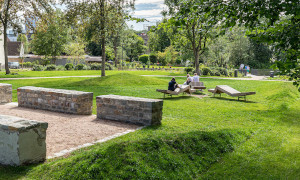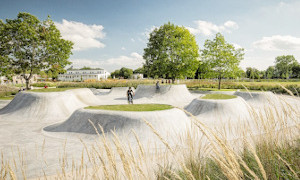In Germany, there are 14 universities offering courses of study in landscape architecture. The bdla is in close contact with the universities through its training working group and is committed to high-quality training so that graduates are well prepared for everyday work.
Ms. Linke, you have been a member of the training working group since 1998 and have headed it since 2019. What is the work of the training spokespersons?
Marion Linke: The main tasks are to deal with issues relating to training, particularly at universities, and to provide regular, trustworthy advice to universities by visiting the respective university sites and, of course, to promote young talent in the association, e.g., through the participation of junior members and students in the working group meetings.
What developments have you noticed in the course of your long active involvement in the AK?
To answer this question, I would like to quote from a recent position paper by the training spokespersons, who state quite self-critically "that the potential of the profession to solve burning societal challenges is largely unknown in politics and the public.
The climate-resilient restructuring of cities and regions as well as the sustainable implementation of the energy transition and environmentally friendly land use concepts are core competencies of landscape architects.
If it is not possible to increase the number of students in a timely manner, the existing shortage of skilled workers will continue to worsen with a simultaneous increase in the demand for skilled workers and the increasing explosiveness of the tasks.
It must be the goal of the entire association, indeed of the profession, to make the importance of landscape architecture/landscape architects in everyday life clearer and, above all, to inspire young people for our profession.
What are the latest decisions or work steps of the committee?
The aim of this position paper is to initiate an initiative and joint strategy of the green associations, the chambers and universities. The aim is to approach the political decision-makers and to convey to them the importance of our profession and thus also the need for adequately equipped courses of study and study places.
In addition, the transition to public relations work is fluid. The general public is not exactly familiar with what the work of a landscape architect consists of. Architects build houses. What do we do? Together with the public relations working group, we will discuss topics such as communicating the landscape architect's job description, starting in schools, helping office owners to facilitate student internships, and advertising more in digital media (films, Internet, . . . ).
"Fridays-for-Future", public discourse on climate change and insect protection - Does the social debate of "green" issues leave young people "cold"?
I wouldn't subscribe to that as a general statement. But that high school students and prospective students would now rush into landscape architecture programs - that is not the case. College enrollment numbers 2013 to 2018 have been stagnant, with fluctuations among college campuses.
Fortunately, there was a noticeable increase in first-year students for the 2020/21 winter semester. One reason for this was that many high school graduates forewent initially planned longer trips due to Corona and immediately took up studies. It remains to be hoped whether this increase will continue after the pandemic.
Are the educational institutions prepared for an "onslaught"? Do you see a need for action, and if so, where and with whom (politics, associations, junior staff, . . . )?
Onslaughts are always difficult, but in our profession they would be desirable and also necessary for society as a whole. In the meantime, qualified professionals are no longer available in sufficient numbers, both in administrations and in independent planning offices, which leads, among other things, to the fact that, for example, the subsidies of the programs that are supposed to make the city and the country more resilient and sustainable, can not be called up more and more often.
What approaches to promoting young talent does the AK see?
Joint action and a strategy of green associations, chambers and universities together are crucial. Furthermore, it is advisable to get involved in politics, especially this year with the so-called election test stones for the Bundestag elections. But also the offers of the federation to the new generation, like and/or the honor of outstanding study work or the Auslobung of student competitions, as e.g. in central Germany, Baden-Wuerttemberg and Bavaria, are proven means of the speech.
How does the training landscape in Germany compare internationally?
According to statements of internationally active colleagues, the bdla as a professional association is little noticeable, differently the trainings, readable in the applications or internship inquiries from all over the world. Straight one in our field of activity is Germany very well and variously with far more than a dozen study locations set up.
To what extent the conurbations in the Ruhr area or Hamburg are to be aimed also as study location, is regularly discussed on the part of the professional associations, chambers and the policy, led however so far to no solution. The intention of this strategy is to bring the study locations to the regions where many planning offices are located and also where most of the first-year students in Germany live.
What is your view of landscape architecture education here?
The plant at the center of teaching is the characteristic of our profession in the broadest sense of "building with green". However, in addition to design, planning and project studies, methodological competence for objective derivations, e.g. the facts on climate change and adaptation, legal competence and communication (especially in participation procedures and negotiations) are crucial.
Personally, I am interested in the holistic education, the breadth of the studies. This includes design and planning strategy, but also technology. For example, in landscape planning, on the one hand, the handling of scale levels M 1:5,000 to M 1:25,000 at the overall urban level (green corridors, climate adaptation concepts, climate strategies, etc.) is essential, on the other hand, for example, in the "water topics" construction details M 1:10 or but plant knowledge in the selection of tree species. Citizen participation and communication of acceptance would then also be an extra topic. In summary, it could be "thinking conceptually, being open to new and experimental things, and acting holistically and interdisciplinarily". At least this is my personal definition of landscape architecture as I understand and live it.
In addition, working on an equal footing with neighboring disciplines such as architecture, urban planning, traffic planning and engineering, the interdisciplinary approach. This should also already be anchored in interdisciplinary study programs, e.g. joint project studies with architects and engineering disciplines.
How did your start in professional life go? Since when have you been running your own office and with what focus?
My career. After completing my studies, which included more than a year of practical experience in companies and landscape architecture firms, I moved from the Technical University of Munich to Landshut. Here I worked for ten years in an office as a project manager, mainly in the field of landscape and urban planning, although I had focused on open space planning during my studies. The breadth of the TUM education and especially the work as a student assistant at the Chair of Vegetation Ecology proved to be an advantage.
Since 2001 I have been running an office in Landshut together with my husband Klaus Kerling, currently with four employees. Our work focuses on open space planning, e.g. square design, schools, daycare centers, commercial outdoor facilities, urban development projects and all facets of urban land use planning. Here from special topics such as wind power plants and open space photovoltaic plants, golf courses and building material recycling centers to forest cemeteries and classic building areas for residential, commercial, industrial and retail use. These are located in both urban and rural contexts. Further focal points of our work are excavation planning and recultivation as well as near-natural watercourse development, production of biotope design measures and environmental construction supervision. Our office is the opposite of international. We limit ourselves to a radius of action of about 100 km and plan "regionally".
Since 1998, a special enrichment of my work has been my work as a lecturer in the 7th semester of the majors landscape planning or, most recently, urban planning at the HSWT Weihenstephan. In addition to the discussions with the students, this offers the opportunity once a year to plan and design without the constraints of economic efficiency and to develop visions for the future - a real enrichment.
In addition, through my involvement in the profession, especially in the AK Ausbildungswesen (Working Group on Training), there are always personal contacts with colleagues who often help you with professional questions.
Have you "regretted" becoming a freelancer?
I have never regretted freelancing. Not a single day.
Thank you very much.
Source: bdla association magazine "Landschaftsarchitekten" 2/2021
- Latitude: 0
- Longitude: 0


